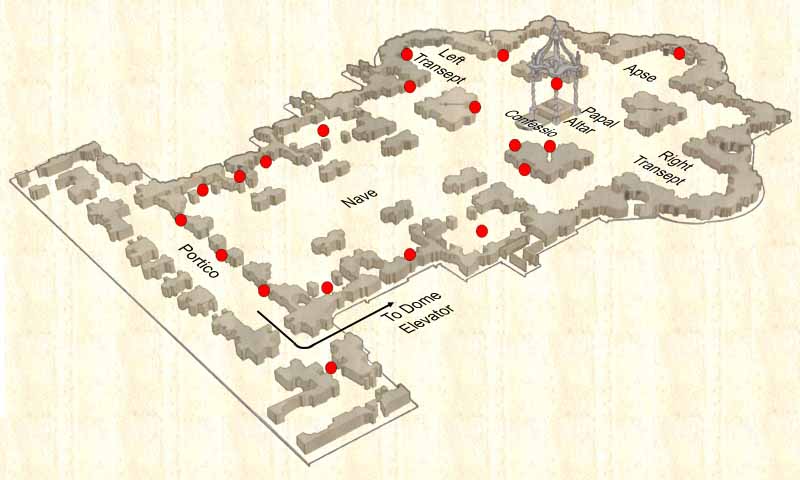|
Points
of Interest
The
Portico
The Portico is larger than many churches, and has many features:
The Holy Door (far right), Giotto's Navicella (over exit to square),
John XXIII's coat of arms (floor).
The
Holy Door
The Holy Door (Porta Sancta), 1949, is opened every 25 years (last
in 2000) by the pope.
The
Filarete Door
Installed in 1445 by Filarete, this is one of the few items from
the old basilica. Note the scenes of martyrdom of St. Peter and
St. Paul at the bottom.
The
Door of Death
The Door of Death is so called because it used to be the exit for
funeral processions. Designed by Giacomo Manzł in 1964, who was
a friend of Pope John XXIII.
Elevator
to the Dome
Exit to the right of the portico to buy tickets for the Dome. The
Elevator (stairs for the brave) takes you to the roof where you
enter the base of the cupola. This area offers a spectacular view
down into the basilica and provides the stairs (313) to the top
of the dome. Returning to the roof you'll find a gift shop, coffee
shop and a second elevator (or stairs) going down.
Statue
of Constantine
The equestrian statue of Constantine, the builder of St. Peter's,
shows the Emperor receiving the vision of the cross before his battle.
This masterpiece by Bernini, unfortunately behind glass, is often
overlooked.
The
Pieta
Michelangelo's masterpiece was carved when he was 24, and installed
before the Holy Year of 1500. The beauty of the Pieta shows the
spiritual view of human suffering. Mary's youthful face contributes
to the image of a mother who has lost her child. This was the only
work Michelangelo ever signed.
|
Chapel
of St. Sebastian
The mosaic altarpiece in the Chapel of St. Sebastian depicts his
martyrdom. Under the altar lies the remains of Blessed Innocent
XI (1676-1689).
The
Blessed Sacrament Chapel
This chapel, with a beautiful tabernacle and angels by Bernini,
is only available for prayer. Often in the morning, you'll find
mass being said here.
Altar
of St. Jerome
Beneath the altar of St. Jerome is the body of Blessed Pope John
XXIII, transferred here on June 4th, 2001.
Statue
of St. Peter
The ancient statue (c. 1300) of St. Peter has toes worn down by
the hands of centuries of pilgrims.
Statue
of St. Longinus
One of the four large statues in the Crossing of St. Peter's,
St. Longinus is the one carved by Bernini. Below the statue is
a stairs often used to enter the grottoes (tombs of the popes).
Confessio
The word 'Confessio' refers to the Confession of faith by St.
Peter which lead to his martyrdom. St. Peter's tomb is behind
the Niche of the Pallium. The pallium is a band of white wool
which the pope gives to each new archbishop. The bronze urn holding
the pallium is often mistakenly thought to hold the bones of St.
Peter.
Papal
Altar and Baldicchino
Rising above the papal altar is Bernini's Baldacchino, his
first work in the basilica. It took him nine years to make it,
from 1624 to 1633. The papal altar, where only the Pope celebrates
Mass, was consecrated by Clement VIII, June 5, 1594, on top of
several other older altars.
The
Right Transept
This are held the First Vatican Council in 1869. Today it is usually
reserved for confession.
|
The
Throne of Peter
The Apse of the basilica holds a grandiose sculpture monument, created
to enclose a wooden throne, once thought to be that of the Apostle.
The luminous alabaster window shows the Holy Spirit as a dove.
The
Monument to Alexander VII
This monument by Bernini is one of the most popular in the basilica.
The skeleton of Death rising from under the Sicilian jasper drapery
provides a striking image.
Left
Transept and Altar
of St. Peter
This area holds the Altar of the Crucifixion of St. Peter, which
is the spot nearest to where the Apostle was crucified.
Statue
of St. Andrew
St. Andrew was the brother of St. Peter. This statue is the location
of one entrance to the grottoes (papal tombs).
Sacristy
and Treasury
Under the Monument to Pius VIII is the entrance to the Sacristy
and Treasury Museum (admission fee). Many precious objects donated
to the Church are kept in the Treasury. At the entrance is a list
of all the popes buried in St. Peter's.
Chapel
of the Choir
This Chapel is where the Liturgy of the Hours are celebrated. The
altarpiece mosaic commemorates the Definition of Mary's Immaculate
Conception. (Dec. 8, 1854)
Presentation
Chapel
The body of St. Pius X lies under the altar of the Presentation
Chapel.
Exit
from the Roof
An elevator (or stairs) provides an exit from the roof, bringing
you back into the basilica.
Baptistery
Chapel
The Baptistry Chapel, by Carlo Fontana, is still in use today. The
superb gilded cover rests on a porphyry sarcophagus cover used by
the Emperor Otto II, and believed to derive from the tomb of Emperor
Hadrian (Castle San Angelo)
|

